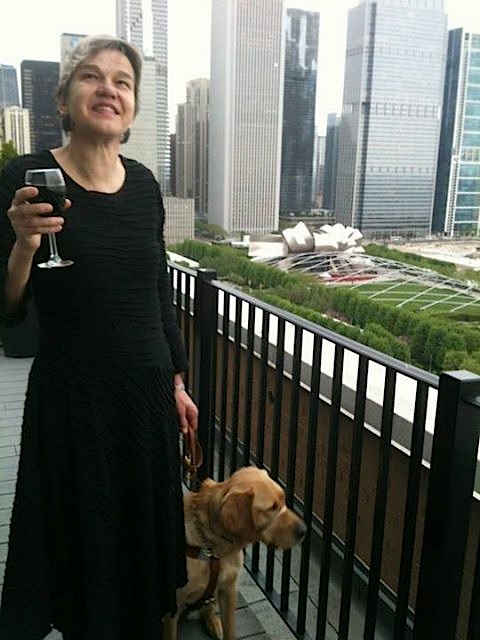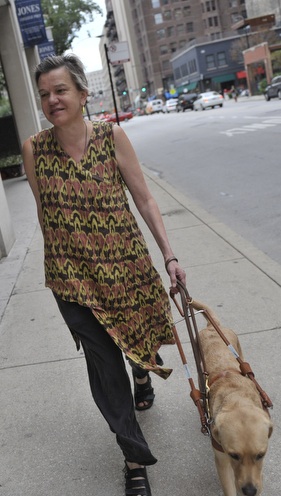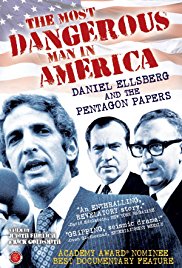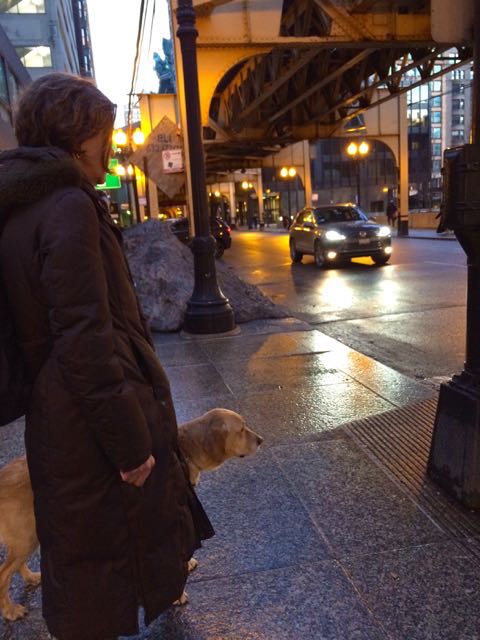One of the many, many things Mike and I did to celebrate our wedding anniversary last week was attend the play This Is Our Youth at Chicago’s Steppenwolf Theatre. The play starred Michael Cera (of Arrested Development and Juno fame) and nearly all the performances were sold out. The only reason we were able to score tickets last Saturday is because that happened to be the day Steppenwolf set aside a number of tickets for a special audio touch tour of the set for people with visual impairments and their guests.
I’ve written a post about Steppenwolf’s audio touch tours before.

That’s me and my previous Seeing Eye dog Harper with our gracious Steppenwolf hosts on stage a few years ago during the touch tour for Who’s Afraid of Virginia Woolf? One of the staff members from Steppenwolf is holding one of the breakable prop bottles and a bouquet of the plastic snapdragons which figure prominently into the play.
Much more than just the tactile experience the name implies, a Touch Tour is a pre-performance program that gives those of us who are blind or have low vision an opportunity to:
- participate in an artistic conversation about a production
- experience a detailed description of the set, props and costumes
- handle key props, set and costume pieces
- tour the set with a sighted guide
- meet the actors and learn about the characters they play
Our This is Our Youth audio touch tour opened with stage manager Cambra Overend explaining what an alley theatre is (the stage is surrounded by audience members on two sides) and how they blocked the scenes to allow everyone in the audience to follow the action. She described different scenes and lines from the play that had given the three young actors particular trouble. Pretty cool for a bunch of blind people to get an inside look, ahem, of a production that’s heading to New York City now. ( This is Our Youth opens on Broadway the 11th of September, and Cambra will be the stage manager for that production, too).
Next came Jack Miggins, the Audio Describer. In addition to describing the play via headphones during the performance, Jack gets on stage before the play while we’re still in our seats to “show” us what the set looks like. He talks while he darts around the stage — that way we can track his voice and get a sense of how close (or far) objects are from one another.
“Here’s the door to the hallway,” Jack called out from stage left last Saturday, knocking on the door so we’d know exactly where it was. The door squeaked as he opened it, too. “You can see into the hallway, but all that’s out here is a ten-speed bike missing a front wheel.” Closer to the front of the stage, he patted the arm of a couch. “It’s brown,” he said. “The décor in this apartment is just different shades of brown, really.” He picked up a plastic milk crate near the couch and told us it had a few record albums in it, including one by Frank Zappa. “Lots of cassettes, too,” he said, giving it a shake so we could here them flopping around. “Oh, yeah, and a squishy Nerf football.”
The play is set in the 1980s, back when I had just graduated from college and could still see. As Jack continued around the stage describing the small kitchen, the door to the bathroom, the phone, photos hanging on the wall, well, I could picture it all so well that I didn’t bother going on stage for the touch tour.
The final act of the audio/touch tour, when the actors are called up on stage to introduce themselves, is always my favorite. Michael Cera, Kieran Culkin and Tavi Gevinson all seemed happy to answer any questions we had, and it was a thrill to have this private audience with them.
The play was about to start then, so we were offered headphones connected to a small device to use for volume control to hear Jack describe scene changes, character entrances/exits and other movements during the performance. Everyone had done such a tremendous job introducing us to the play ahead of time that I opted to go without the headphones. As the play progressed, I understood why Jack had pointed out certain things during his on-stage romp during the pre-production presentation. Two examples:
- Kieran Culkin’s character told his parents he was working as a bike messenger, but the missing bike wheel told us he was a liar.
- When Michael Cera’s character wanted to “play catch” in the apartment, we knew he was holding a Nerf football.
The timing of this particular audio touch tour was perfect: it will be fresh on my mind when I sit on a panel at the Leadership Exchange in Arts and Disability (LEAD) conference this Tuesday. The conference is in Chicago this year, and it’s put together by the Kennedy Center.
Cultural arts administrators from all over the world (most of them responsible for accessibility at their respective cultural arts organizations) are in town to attend seminars and workshops on everything from” Determining Who is Eligible to Purchase Accessible Seats” to “Reaching out to Museum Visitors with Memory Loss and Dementia.” The panel I’m sitting on is called “Finding and Nurturing an Audience for Audio Description” and encourages conference atendees to hear from experts who use Audio Description services-the audience members of Steppenwolf Theatre Company!
The conference web site explains that we’ll “provide an informative journey on the best way to market the arts as well as the challenges and successes in accessing arts programs.” Evan Hatfield from Steppenwolf will moderate the panel along with Deborah Lewis, CEO of California’s Arts Access Now. George Abbott, who was born blind, and Sally Cooper, who has a visual impairment but still has some sight, will be sitting on the panel with me, and it meets on Tuesday, August 5 from 11:30 am to 12:45 pm at the Sheraton Hotel at 301 North Water Street in Chicago.
LEAD conference attendees will be invited to join us at an audio touch tour of The Qualms at Steppenwolf that same night, too, so if you’re at the LEAD conference and happen to have found this blog post, I hope you’ll join us.




